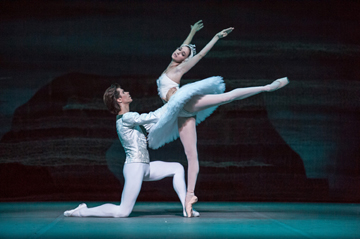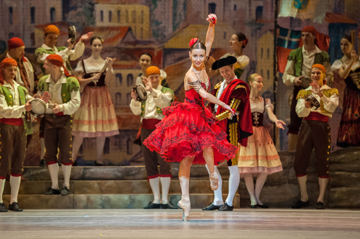Dance: The Bolshoi Ballet at Lincoln Center
By Dawn Lille
ART TIMES online October 2014
 Artem Ovcharenko (Prince Siegfried) and Anna Nikulina (Odette-Odile) in Bolshoi Ballet's "Swan Lake" presented by Lincoln Center Festival 2014 on July 16, 2014 at David H. Koch Theater. Photo Credit: © Stephanie Berger |
It was akin to experiencing a deflating balloon to witness the Bolshoi Ballet’s Swan Lake after explaining to a companion the aesthetic differences between the Bolshoi of Moscow and its venerable competitor, the Maryinsky of St. Petersburg.
The Bolshoi dates back to 1776 and over time has been known for its emphasis on drama and mime, its extravagant bravura, its use of folk dance and its comic ballets. Much of this style was shaped by Alexander Gorsky, a choreographer who took over the company at the beginning of the 20th century. When the choreographer Alexander Ratmansky was in charge (2003 – 2009) it acquired a more modern, abstract point of view.
The Maryinsky (also known for a long time as the Kirov), quintessentially elegant, has always allowed for more abstraction, beginning with Michel Fokine early in the last century. Both companies have impeccable training schools and dancers sometimes go back and forth.
But in Swan Lake, probably the most famous classical ballet in the world and their first presentation at the Lincoln Center Festival, there was no drama, no bravura, no passion and so many repetitious, boring dance sequences that the beautifully trained, languid bodies soon began to lull one to sleep.
The story, based on various folktales, centers on a prince, Siegfried, who has come of age and must marry. He falls in love with the swan queen, Odile, actually a princess who has been put under a spell by the evil magician Rothbart. The prince pledges his eternal love to her, the only thing that can break the spell. But when he chooses the black swan Odette (Rothbart’s daughter), thinking she is Odile, he dooms their love. The single role of the white and black swan is one of the most difficult in ballet.
Swan Lake was first staged on the Bolshoi in 1877, with choreography by Julius Reisinger to Tchaikovsky’s music. It was not successful. The version that has come down to us is that choreographed in 1895 by Marius Petipa and Lev Ivanov in St. Petersburg, with later additions by Fedor Lopukhov. Tchaikovsky died before the first performance, thinking that his magnificent score was a failure.
The cast I saw had Anna Nikulina as Odette/Odile, Artem Ovcharenko as Siegfried and Denis Rodkin as the “Evil Genius.” This production credits Yuri Grigorovich, the company’s artistic director and choreographer from 1964 to 1995 who is now listed as a ballet master, with its “choreographic version.” But it also lists “scenes” by Petipa, Ivanov and Gorsky. All of this adds up to a pastiche that is a mess.
 Kristina Kretova as Kitri in Bolshoi Ballet's "Don Quixote" presented by Lincoln Center Festival 2014 Photo Credit: © Stephanie Berger |
In the hundreds of versions of this ballet around the world there have been many variations, but this one is weak artistically and choreographically. The Evil Genius (aka Rothbart) is here almost a Freudian alter ego to the prince, who may or may not be dreaming the whole thing. Nikulina showed a bit more life as Odile, but neither she nor Ovcharenko displayed any emotion in their second act love duet. The patterns on stage sometimes had odd lines of dancers sticking out, giving the impression of a big mistake.
Petipa, who reigned as a choreographer in Russia for over forty years, choreographed Don Quixote in 1869 for the Bolshoi. He staged a slightly different version, with less folk dancing, on the Maryinsky in 1871. In 1900 Gorsky created a new production for the Bolshoi, using Petipa’s libretto and some of his choreography, but adding more Spanish dances.
The company’s current production, listed as a “new version” by Alexei Fadeyechev of Petipa and Gorsky’s choreography, at least showed the dancers in a better light. A festive piece created after the novel by Cervantes, it bears little relationship to this great literary work, centering on the romance between Kitri and Basilio.
Even at its best, this ballet, filled with one pseudo Spanish or gypsy dance after another, is little more than a spectacular production. But when danced full out it is an exhilarating one. Its famous pas de deux is performed at countless galas and showcases. The dancers displayed more of their exemplary technique here, but it was annoying to see them stop after each dance and wait for the applause. Olga Smirnova as the Queen of the Dryads, a small role for her, seemed to levitate above everyone else as an inspired performer.
The less said about Spartacus, which Grigorovich created in 1968, the better. Based on the novel of a slave rebellion, to music by Khachaturian, it is extravagant kitsch at its best. This was not the case this time around.
In short, it is long past the time of Grigorovich. The recent intrigue in a company famous for intrigues, in which the artistic director, Sergey Filin, was disfigured and almost blinded by an acid attack, may well have created a vacuum in artistic direction. Hopefully, the next time we see the Bolshoi Ballet, it will have incorporated some of its former glory.
dawnlille@aol.com
